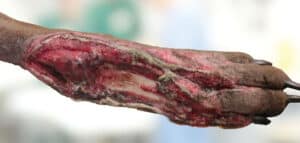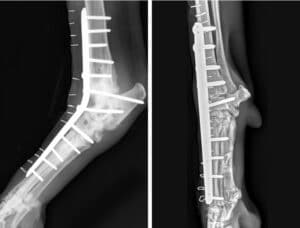Arthrodesis is defined as the irreversible surgical fusion of two or more bones of a joint. This creates an osseous bridge, preventing joint motion, and allows the arthrodesed joint to transmit weight-bearing forces.
In essence an arthrodesis is iatrogenic and is created by the surgeon. The result is that any pain as a result of motion or instability of the joint is alleviated.
Ankylosis is defined as the gradual development of joint stiffness due to a pathologic process. Joint stiffness develops due to fibrosis of the joint capsule and the periarticular tissues. The result is the formation of intraarticular adhesions and osteophytes.
Indications for Arthrodesis
It is important to realise that an arthrodesis is a salvage procedure. This means that the procedure is irreversible once performed. As a result, an arthrodesis is generally performed when conservative management has failed or unlikely to be successful and the benefits of arthrodesis outweigh the effects of the underlying disease process/instability that is present at the joint. The surgeon should carefully evaluate the patient to assess for any other concurrent comorbidities that may affect the success of the procedure. The more common indications for arthrodesis are listed below:
-
- Joint instability – Hyperextension injury of the carpus is the most common indication for performing a pancarpal arthrodesis (surgical fusion of all of the carpal joints). The high tensile forces following normal weight bearing make conservative treatment futile.
- Intractable arthritis or joint pain – This may be due to a chronic articular fracture that was previously missed or secondary to an underlying joint disease such as an erosive polyarthritis.
- Persistent luxation or instability of the joint
- Low grade pain involving the joint
- Revision of previously failed surgery
- Non-reconstructable articular fractures
- Limb salvage procedures – The most common being distal radial osteosarcomas
- Neurological injury – Damage to the radial nerve can prevent extension of the carpus leading the animal to ‘knuckle over’. A pancarpal arthrodesis may be beneficial in these circumstances, but is rarely performed.

Above is a dog that has suffered a severe shearing injury of the dorsal and medial aspect of the carpus. The instability and articular surface damage to the joint means that options to salvage this limb are limited. A pancarpal arthrodesis was performed with an external skeletal fixator.
The most commonly performed arthrodesis procedures performed at NDSR are pancarpal arthrodesis, pantarsal arthrodesis and a partial tarsal arthrodesis. These procedures are generally accomplished using internal fixation with plates and screws.

Left image: Pantarsal arthrodesis Right image: Pancarpal arthrodesis
Key Points
- All joints with the exception of the hip can be arthrodesed
- Function is especially good following fusion of the carpal and tarsal joints, and to a lesser degree the shoulder
- Due to compromised function following elbow and stifle arthrodesis joint replacement may often be considered in these cases
Arranging a referral for your pet
If you would like to refer your pet to see one of our Specialists please visit our Arranging a Referral page.